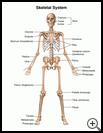
Colles' Fracture
________________________________________________________________________
KEY POINTS
- A Colles’ fracture is a break in the lower arm bone at the end of the bone on the thumb side of your wrist.
- Treatment may include surgery, a splint or cast, and special exercises to help your wrist get stronger and more flexible.
- Follow the full course of treatment your healthcare provider prescribes.
________________________________________________________________________
What is a Colles' fracture?
A Colles’ fracture is a break in the lower arm bone called the radius. The break is at the end of the bone on the thumb side of your wrist. The break may be just a bend or small crack in the bone, or the bone may break into pieces or shatter.
What is the cause?
Wrist fractures are often caused by a fall. They may also be caused by a direct hit to the wrist or a medical condition that causes weak or brittle bones.
What are the symptoms?
Symptoms may include:
- A snapping or popping sound at the time of the injury
- Pain, swelling, bruising, or tenderness that happens right after the injury
- Pain when the injured area is touched
- Pain or swelling that keeps you from bending or using your wrist
- An area of the wrist or hand that is cold, pale, or numb
- A change in the shape of the wrist
How is it diagnosed?
Your healthcare provider will ask about your symptoms and how the injury happened. Your provider will examine you. You may have X-rays of your wrist.
How is it treated?
The treatment depends on the type of fracture.
- If you have an open wound with the fracture, you may need treatment to control bleeding or prevent infection.
- If the broken bone is crooked, your healthcare provider will straighten it. You will be given medicine first so the straightening is less painful.
- Sometimes surgery is needed to put the bones back into the right position.
- Your provider may put your wrist in a cast or splint to keep it from moving while it heals.
- If you have a cast, make sure the cast does not get wet. Cover the cast with plastic when you bathe. Avoid scratching the skin around the cast or poking things down between the cast and your skin. This could cause an infection.
- You will not be able to bend your wrist while the cast or splint is in place. You may need someone to help you with daily activities such as cooking, housework, dressing, bathing, and driving.
With treatment, the fracture may take up to 8 weeks to heal. You may need to do special exercises to help your wrist get stronger and more flexible. Ask your healthcare provider about this.
How can I take care of myself?
Follow the full course of treatment your healthcare provider prescribes. Also:
- To keep swelling down and help relieve pain, your healthcare provider may tell you to:
- Put an ice pack, gel pack, or package of frozen vegetables wrapped in a cloth on the injured area every 3 to 4 hours for up to 20 minutes at a time for the first day or two after the injury.
- Keep your wrist up on pillows so that it is above the level of your heart when you sit or lie down.
- Take pain medicine, such as ibuprofen, as directed by your provider. Nonsteroidal anti-inflammatory medicines (NSAIDs), such as ibuprofen, may cause stomach bleeding and other problems. These risks increase with age. Read the label and take as directed. Unless recommended by your healthcare provider, you should not take this medicine for more than 10 days.
Ask your healthcare provider:
- How and when you will get your test results
- How long it will take to recover
- If there are activities you should avoid and when you can return to your normal activities
- How to take care of yourself at home
- What symptoms or problems you should watch for and what to do if you have them
Make sure you know when you should come back for a checkup. Keep all appointments for provider visits or tests.
How can I help prevent a Colles’ fracture?
- For sports where there is a high risk of falling, such as skateboarding or hoverboarding, always wear protective equipment.
- Keep your bones healthy. Ask your healthcare provider about bone density tests and whether or not you need calcium and vitamin D supplements.
- For older adults:
- Walk daily and do exercises for the upper body with light weights to help your balance and strength. This can help prevent falls and fractures.
- Make changes in your home to make it safer. For example, remove clutter and loose rugs. Make sure there are secure rails on all stairs. Make your bathroom safer with grab bars and a no-slip floor surface.

